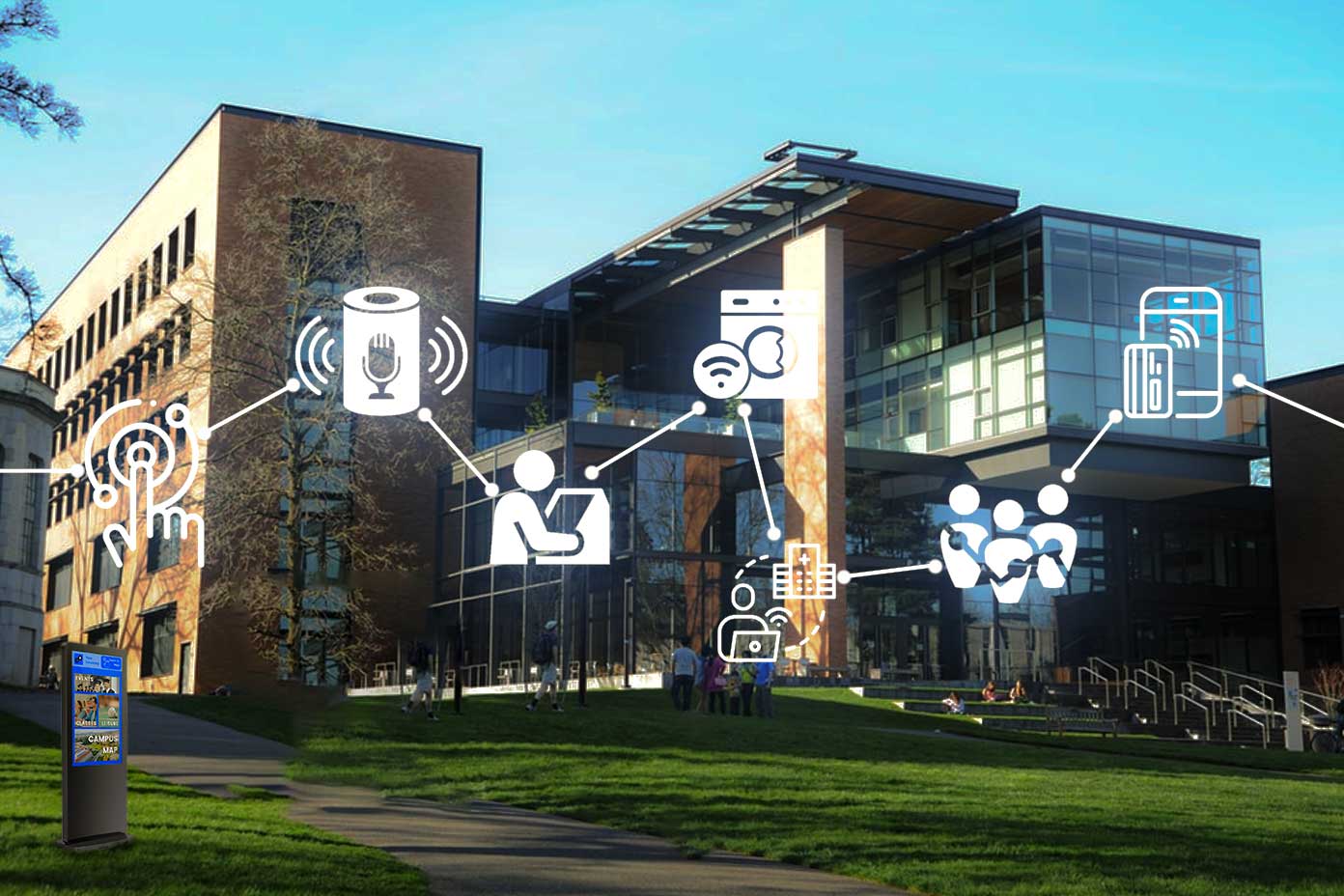
Would you love to live in a building that could communicate with you? Buildings that could tell you when it is too cold, knows when to turn on the lights, and that can be controlled by your phone. These buildings are the exact type of buildings we will consider in this post about smart campuses for educational institutions.
Advantages of Smart Campuses
Smart buildings can help educational institutions improve the learning experience by creating a comfortable, and personalized learning environment. Students and faculty would experience digital, and fully connected classrooms that would make the classrooms easily accessible to all students equally.
Smart campuses with sensors to measure the structural integrity of the buildings would also identify and prevent disasters from happening. There are sensors that measure water pressure in water pipes to identify damages in pipes in the buildings. All these sensors will help reduce maintenance costs.
Smart buildings are also fully monitored, so the security of the campus would also be improved. All buildings would be monitored in real-time, with access controls, alerts, and emergency response capabilities.
Smart buildings that control heating and cooling, lighting, water, and other preferences will also make the campus environmentally friendly by reducing its carbon footprint.
Smart campuses are also flexible and adaptable, which makes it easy for newer technologies in the future to be integrated to the system over time.
Smart campuses also allow students to get access to real-time information about campus events, services, transportation, and academic resources through mobile apps and digital platforms.
A smart campus due to the use of data analytics and data-driven decision-making processes will save more money in the long run than a traditional campus. The cost saving will be through energy efficiency, reduced maintenance expenses, optimized resource utilization, and enhanced operational efficiency.
Disadvantages of Smart Campuses
The obvious disadvantage of having smart buildings is the constant surveillance and the effect it has on the mental health of the students and faculty. It will always be in the back of everybody’s minds that they are constantly being watched.
Another problem with smart buildings in educational institutions is the cybersecurity concerns there are with handling so much personal data. There are always concerns with recording locations of identifiable people.
One of the main concerns that an educational institution has is the initial upfront investment required to set up the infrastructure, sensors, networking, and software systems. The initial investment is very high due to the specialized nature of the installation of systems.
The systems such as energy management, security, water management, heating and cooling management are very complex, and it increases the complexity of the management and maintenance required. It requires expertise, and specialized skills to manage them. Although, the staffs already employed can be trained to handle them.
A smart campus relies heavily on technology which is prone to malfunctions, software bugs, or hardware failures. Regular maintenance and updates are essential to ensure the reliable operation of smart campus infrastructure. Maintenance staff should also be trained to be able to repair and/or replace the malfunctioning hardware.
There already exists a digital divide amongst people who do not have easy access to technology or due to the different comfort levels of using smart systems. Installing a smart system might increase the digital divide amongst and create disparities in accessing campus resources and services.

How does a Campus Become “Smart”?
A campus becomes “smart” when it has embedded Internet of Things (IoT) devices, sensors, and other technologies such as smart cameras that monitor movement.
IoT sensors such as RFID sensors and cards to log students and teachers in a classroom, smoke detectors to warn of fire, as well as carbon monoxide poisoning, temperature controls that automatically control the climate within buildings, smart water control systems, and air quality control systems. These sensors would help keep the buildings in stable pre-defined conditions with minimal oversight and management.
AI technologies like face detection cameras, as well as student identification AI algorithms can be enabled in CCTV cameras around the campus to identify and track the movements of students.
Advanced AI technologies can also be enabled for predictive maintenance. These algorithms can detect potential issues before they occur.
One of the main advantages of transforming a traditional campus into a smart campus is all the data that will be generated through it. All the data can then be analyzed to generate insights which will provide actionable insights for optimizing campus operations and resource management.
Implementation of digital learning platforms, interactive classrooms, online libraries, and educational resources to support innovative teaching and learning practices is also one of the major steps to take to create a smart campus.
Wrapping Up
In conclusion, the concept of smart campuses marks a significant paradigm shift in the realm of education, offering a glimpse into a future where technology seamlessly integrates with learning environments to optimize experiences for students, faculty, and administrators alike. Through the deployment of Internet of Things (IoT) devices, sensors, and advanced AI technologies, educational institutions can create dynamic, responsive spaces that adapt to the needs of their occupants in real-time.
The advantages of smart campuses are manifold. From enhancing the learning experience through personalized environments and digital classrooms to improving operational efficiency and reducing maintenance costs, the potential benefits are substantial. Furthermore, the integration of AI-driven security systems and real-time monitoring enhances campus safety, providing peace of mind to the entire community. By controlling heating, cooling, lighting, and other resources based on demand, smart campuses also contribute to environmental sustainability, reducing carbon footprints and promoting energy efficiency.
However, alongside these benefits come challenges. Privacy concerns stemming from constant surveillance and data collection, as well as cybersecurity risks associated with handling vast amounts of sensitive information underscore the need for robust policies and safeguards. Moreover, the initial investment required to implement smart infrastructure, coupled with ongoing maintenance and staff training, poses financial and logistical hurdles for educational institutions.
Despite these challenges, the transformative potential of smart campuses is undeniable. By harnessing the data generated by IoT devices and leveraging AI-driven analytics, institutions can gain valuable insights to optimize resource allocation, streamline operations, and support data-driven decision-making processes.
In essence, the journey towards smart campuses represents a forward-thinking approach to education, leveraging technology to create inclusive, efficient, and sustainable learning environments.





